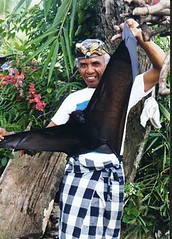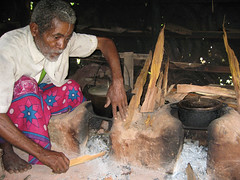Madagascar, officially the Republic of Madagascar and previously known as the Malagasy Republic, is the world's fourth largest island. While it sits just off the eastern coast of Africa, the land mass has more in common with the Indian sub-continent than with Africa. And the people of Madagascar have more in common with the people of Indonesia than with the people of Mozambique, its neighbor to the west.
|
The Madagascar land mass split from India about 88 million years ago, resulting in an isolated environment for the native plants and animals to develop into the unique breeds that exist there now. Over 90 percent of Madagascar's wildlife is not found anywhere else in the world. However, much of the biodiversity is threatened by encroachment by humans. Because so much of the island has been denuded of trees in order to be turned into charcoal for cooking, the rains run off the island, bringing its red soil into the sea, making the island appear to be bleeding.
Like India, Madagascar has streaks of semi-precious stones underground. Garnets, amethysts, sapphires, topaz, tourmalines, citrines, aquamarines, moonstones, opals: all can be found in Madagascar. The markets are full of stalls offering these stones, rainbows of color arrayed for all to see and for the lucky ones to buy.
|
 |
 by Praziquantel by Praziquantel |
During the golden age of piracy in the 17th and 18th centuries, pirates took refugee in the coves on Madagascar. The island wasn't unified until France absorbed the island into the French colonial empire. The island gained its independence from France in 1960. When I arrived, the last elected president, Marc Ravalomanana, had just come to power. The world, especially the west and the United States government, had great expectations of him.
That was the stage onto which I landed.




No comments:
Post a Comment